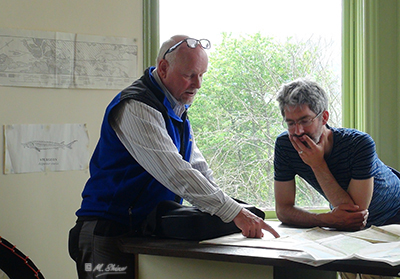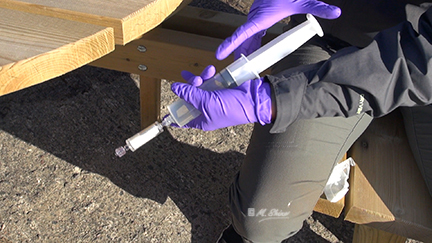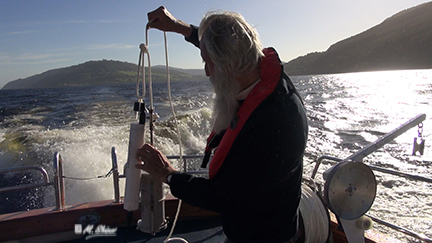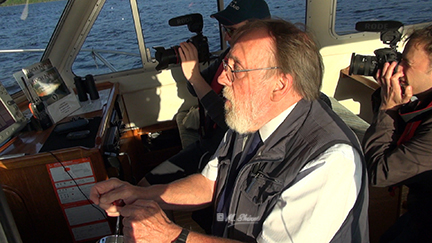Prof. Neil Gemmell assembled a scientific team with a wealth of experience and enthusiasm. and we looked forward to taking part in the project.
Saturday 2nd June 2018
Team leader Prof. Neil Gemmell, Gert-Jan Jeunen and Cristina Di Muri arrived.
Sunday 3rd June 2018
There was a team meeting at the Loch Ness Project lab where sampling strategies and locations were decided and equipment reviewed.
We were joined by Prof. Eric Verspoor and Lucio Marcello from the University of the Highlands & Islands. Also the Danish contingent : Tom Gilbert, Kristine Bohmann and Christina Lynggaard.
That evening the protocols, equipment and ideas were reviewed and the team familiarised with MV Deepscan.
Prof. Eric Verspoor and Lucio Marcello showed where their Pioneer boat and a dunghy would coordinate the shoreline sampling. It was essential that samples were processed quickly. The small UHI boats could get in closer than M.V. Deepscan.
Deepscan commenced mid-water sampling the following night. |

Adrian Shine and John Minshull plan how to connect up the sampler. We have three samplers, the one Neil Gemmell is checking is a Marpet Sampler.

Prof. Eric Verspoor and Lucio Marcello planning their small boat sampling sites.
|
Week commencing Monday 4th June 2018
The UHI's Pioneer with Prof. Eric Verspoor conducted the water sampling along the shore.
Some sites of course were easy to access by road but others needed a shallow draught boat to sample where the shore was too steep or a long walk in.
Processing the water entailed extracting a full syringe of the sampled water and pushing it through a special fine pore filter. As more of the sample is pushed through the filter it becomes harder to push because the process concentrates the sample.
That evening as the shore sampling drew to a close for the day, we boarded Deepscan to test the Friedinger water sampler. John Minshull and Adrian Shine had modified the release mechanism on the Friedinger earlier that day. After several tests at up to 100m we were all satisfied with the deployment routine and that the equipment was firing correctly.The weather was good but there was a cool breeze so repeatedly handling 100m of cold wet rope was with gritted teeth.
The team headed north in the evening sun
The next night would be deep sampling at 200m __________________________________________
We went out again at 6pm to go to the north basin to sample at two stations with 3 depths sampled with replicates.
Aboard Deepscan were Prof. Neil Gemmell, Adrian Shine, Cristina di Muri, Gert-Jan Jeunen, John Minshull, Maralyn Shine, Zander and Kieran.
It was yet again a beautiful night asnd we briefly approached Urquhart Castle for a photo call before the serious work began.
Now in seriously deep water we sampled first at 200m, (deeper than the height of the London Telecom tower). We motored south for the second station sampling. At local sun-down, fleeces and hats came out as the loch became lumpy, leaden coloured and cold. When the boat heading fell off the wind, she rolled and we needed one hand for the boat and one for ourselves! However the sampling continued and the processing was relentless.
At each station, a profiler was lowered and its temperature data uploaded to a laptop. Having read the data and being happy to proceed, the Freidinger sampler was scrupulously cleaned and lowered to the correct depth by a measured line from the ships bows. At the correct depth the messenger weight was applied to the line which on reaching the sampler, triggered the mechanism which closed and trapped the water.
The retrieval was from aft. Though the electric hauler helped to pull the sample up from the depths, the cold, wet rope still had to be flaked by hand ready for the next drop.
The final samples were extracted and all were back at the harbour at 10 pm. Back at t he lab the the sample was quickly decanted into a sterile bottle and systematically pushed through filters. Then a buffer presevative was added, the tube labelled and it was ready to be sent off for full lab processing.
It was a meticulous and painstaking job especially when , fingers are numb with cold and it's been a long day. |
Loch Ness Water Sampling processing DNA
The water is taken into a syringe and pushed through the special filter.

The eDNA has been separated and the excess water drains away.
Obviously sterility, labelling and correct storage is essential for a successful experiment.

The Freidinger with the RBR XR 420CTD profiler.

Skipper John Minshull holds the boat head to wind while the sampler is deployed off the bows. The film crew are getting filmed too ... sorry !
|
12th June 2018
The weather calmed for the final sampling . A variety of sampling devices had been used, the first being a metal Freidinger type supplied by Prof. Neil Gemmell of Otago University. The second was the transparent perspex Freidinger supplied by Adrian Shine of the Loch Ness Project and finally the Niskin Bottle brought by Prof. Eric Verspoor of the University of the Highlands and Islands. Aboard on the 12th were Prof. Neil Gemmell (Otago Univ) Adrian Shine (LNP) , Prog. Eric Verspoor and Lucio Marcello (UHI), Gert-Jan Jeunen (Otago Univ.) The skippers were John Minshull and Ali Matheson and the videographer was Maralyn Shine.
Water samples were taken at every 50m down to 200m, from the north and south basins. Also the team visited two river mouths to sample water where methane was gassing from the sediment. As you can see from the video, everyone was enjoying the work and finally a quaich of water brought up from 200m was shared around to celebrate the end of the sampling..
Adrian Shine said ‘DNA sampling is a new field for the Loch Ness Project though we are no strangers to water sampling and looking at it the hard way, through microscopes. These concentrated eDNA samples bring a new elegance to biology.’
The samples were processed by an international team. |





